Рестораны Лондона
French
 Maison Francois
Maison Francois
https://www.maisonfrancois.london/
The brainchild of restaurateur Francois O’Neill and former MasterChef: The Professionals finalist Matthew Ryle, Maison Francois is an upmarket French restaurant in St James’s which pays homage to the grand brasseries of Paris. The dining room is a large and imposing space, featuring impossibly high ceilings and an oversized bronze clock hanging from the wall above the pass. However, clever design hacks, including curved banquettes and tables separated by wood panelling and latticed glass, help the room to retain an air of intimacy and stop it from feeling soulless. The menu of simple yet meticulously crafted brasserie classics is designed for sharing and is written almost entirely in French, so you will need to know your poulet from your poisson. Maison Francois is also the kind of place where you’ll see a waiter zipping past with something delicious and immediately want to add it to your order, a request which the well-drilled staff will be happy to accommodate.
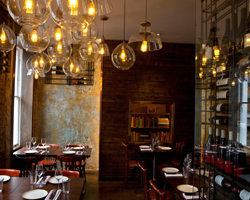 The Ninth
The Ninth
https://www.theninthlondon.com/
The Ninth may be a Charlotte Street veteran these days, but Jun Tanaka’s exquisite cooking remains as fantastic as ever, and for our money The Ninth is still one of the best restaurants in these parts. Sultry browns dominate the dining room, from dark wood floors and chestnut tables to a plush, chocolate brown leather banquette, which runs the length of the wall. The Ninth feels chic and refined but still relaxed — Tanaka’s background is very white tablecloth but there are none here, and the walls are an abstract collage of old plaster and exposed brickwork. The service too is just the right balance of attentive and friendly. We kick things off with an elegant plate of torched mackerel, each dainty mackerel slice adorned with a sliver of kohlrabi and a shard of pickled lemon. It’s simple, but exquisite. Two pasta courses raise the bar even further — Tanaka’s signature dish of pipe rigati pasta with winter truffle and egg yolk is another example of less is more done well, and jet black cuttlefish malloreddus comes with crispy squid and bottarga, delving into multiple layers of saline funkiness.
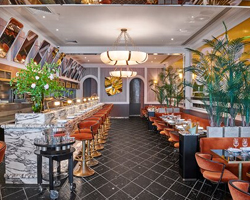 Le Comptoir Robuchon
Le Comptoir Robuchon
https://www.robuchonlondon.co.uk/
The late Joël Robuchon was the world’s most Michelin-starred chef and the 2006 arrival on West Street of his l’Atelier de Joël Robuchon marked the decisive moment when the planet’s foremost restaurant brands deemed a presence in London essential. The lasting impact of the chef on London has been underlined by this supremely assured revival of the Robuchon brand, precision tuned for globetrotting (and deep-pocketed) Mayfair diners. The dining room looks stunning, illuminated by floor-to-ceiling plate glass windows, with a long marble bar by the entrance giving way to a long open kitchen and counter on one side, plush velvet-upholstered banquettes on the other and cleverly angled mirrors providing excellent people-watching opportunities of the glamorous goings-on. Luxury ingredients abound on a menu overseen by chef Jeremy Page (who was in charge of the kitchen on our visit, but has since left), who spent 10 years with Robuchon at the original l’Atelier in Paris and headed up the kitchen of the London outpost. The smoothest slice of pressed foie gras, pink and veined like a piece of alabaster, is topped with a jammy layer of fig, while there’s more foie parcelled up with langoustine in a fat pin cushion of ravioli.
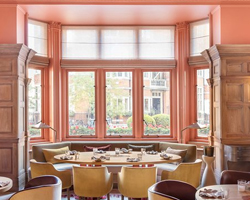 Helene Darroze at the Connaught
Helene Darroze at the Connaught
https://www.the-connaught.co.uk/
French chef Hélène Darroze opened her “exceptional” dining room at The Connaught at the trail end of the fine-dining boom in 2008. Having sensed that luxury in the 2020s will be very different to the noughties version, she has treated her restaurant to an update which has transformed the previously stiff-upper-lip British surrounds into something more chicly French and, in her words, feminine. The wood panelling has been brightened by several shades, the straight lines replaced with flowing curves (including the tablecloth-free round oak tables) and a soft pink colour scheme introduced. The old duffers who were apoplectic when Angela Hartnett became The Connaught’s first female head chef in 2003 must be turning in their graves. Darroze’s cooking remains a lightened-up version of the classic haute cuisine she learnt with Alain Ducasse, showcased on two tasting menus (five or seven courses) – and if you want to push the boat out even further, there are supplements for lobster, caviar and wagyu beef.
Italian
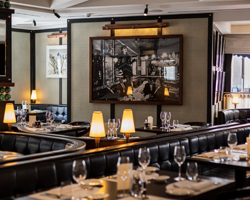 Margot
Margot
https://www.margotrestaurant.com/
This classy Italian off Drury Lane is the result of years of impressive networking. Co-founders Nicolas Jaouën and Paulo de Tarso certainly know their hospitality: de Tarso spent nearly six years as maître d’ at Bar Boulud, while Jaouën was the first general manager of Balthazar. Still, almost four years after opening, Margot doesn’t need comparing with the pair’s previous projects and has established itself as one of the most reliable bets in Covent Garden. Margot is an impressive-looking proposition, a handsomely appointed, high-ceilinged space occupying a plum corner spot near the Royal Opera House and Theatre Royal. Attention to service is the top priority, from the white-suited Italian bar staff who can rustle up a classic cocktail to the eye-catching crockery and the attentions of the charming waiters. We kicked off with uovo in camicia, a soft-poached duck egg that burst forth its rich, fondant-textured yolk over a parmesan polenta that was almost like a chunky cheese soup, with peppery seasoning courtesy of fresh watercress. Perfectly timed pan-fried scallops, meanwhile, came crusted with spicy nduja, some cauliflower purée offering a welcome blandness to offset the heat.
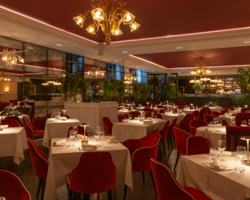 Bardo St James’s
Bardo St James’s
https://bardostjames.com/
Bardo is the new Italian on the block and after opening was almost immediately fully booked every night. The draw? While London is filled with pizza and pasta offerings, Bardo feels experiential. Indeed, with evocative language and a rich, red colour palette, the website promises to transport diners back to Italy’s famed Dolce Vita era, a time known for glamour and sensuality. In person, this concept comes to life with fabulous service, dramatic interiors and live music. The menu is an example of how, when it comes to food, Italians arguably do it best. Diners are nudged towards a series of courses, starting with antipasti. Keep things light with fresh, yellow tail with datterino tomatos, soya and preserved lemon for a citrusy kick, or indulge in sharing slices of pizza covered in glistening fior di latte.
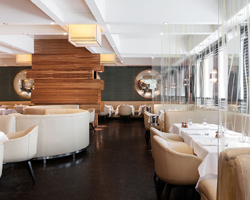 Locanda Locatelli
Locanda Locatelli
https://www.locandalocatelli.com/
“Still a top restaurant providing true Italian food and style at its best”, Giorgio Locatelli’s “sexy” Michelin-starred Marylebone flagship is the very essence of la dolce vita – a perennially glamorous masterclass in design, complete with gauzy drapes, cream leather and dramatic fish-eye mirrors, plus some capacious but discreet booths for those who have romance on their minds. There’s even a special lining in the ceiling, “so you never need to talk loudly to hear one another”. Meanwhile, Locatelli’s kitchen delivers value, authenticity and culinary cred as it rings the seasonal changes with an array of clear-flavoured dishes inspired by provenance-led cucina rustica. Incomparable hand-crafted pasta is the undisputed star turn (lobster linguine, tagliatelle with kid goat ragù, cod ravioli with chickpea purée and rosemary oil, for example), but everything is imbued with earthy freshness – from a flavour-burst green bean salad with potato, rocket, shallot dressing and black truffle to roast monkfish with walnut and caper sauce or char-grilled spring lamb partnered by stewed peppers and aubergine caviar.
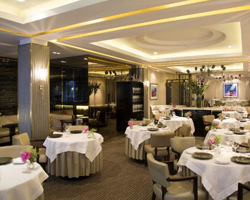 Murano
Murano
https://www.muranolondon.com/
“It’s hardly surprising that down-to-earth Angela Hartnett is behind this magic” commented one fan after dining at Michelin-starred Murano and giving it a hearty “bravo” in the process. Somehow, this smart performer manages to offer “the perfect combination of atmosphere, privacy, service and food” in a sleek setting that suggests low-key sophistication – think pale white-and-beige tones, the odd art-deco flourish and, of course, an abundance of Murano glass. Hartnett looks at Italian cuisine through English eyes, but her vision is true and the food created by her impressive kitchen brigade represents “simplicity at its absolute best”. Her menu is also ultra-flexible, allowing you to choose up to five courses at will, from a summery dish of tomatoes served with Cornish mussels, slivers of lardo and seaweed butter to caramelised Amalfi lemon tart or a voguish pairing of Brillat-Savarin cheesecake, lemon and blueberries with cucumber sorbet.
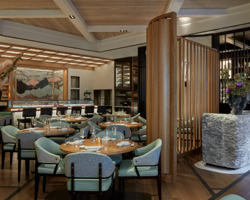 Koyn
Koyn
https://koynrestaurants.com/
Restauranteur Samyukta Nair’s knack for nailing restaurant concepts is uncanny. It’s like she’s playing a game of Pokémon Go, but the prizes are global restaurant formats. She’s ticked off Indian and Chinese with Bombay Bustle, Jamavar and MiMi Mei Fair, and now she’s onto Japanese with KOYN. Heading up her operation is chef Rhys Cattermoul whose talent for balancing authenticity with crowd-appeal is impressive. The menu is so long it’s the type to strike fear into your heart as you wonder how a kitchen can ever nail such variation. In less capable hands it might feel phoney, but here the brigade of chefs working behind a glass wall don’t skip a beat. It’s busy and crowded in the dark and moody basement dining room, but dishes fly out — handled by some of the kindest staff we’ve come across recently — and are truly masterful. Small things don’t allow their size to denote their impact. Petite, cold piles of spinach dressed in a creamy sesame dressing put a wonderful spin on Gomaae while two single pieces of prawn tempura are so crisp and sweet they leave us with a lasting impression.
 Socca
Socca
https://soccabistro.com/
Two-Michelin-starred chef Claude Bosi (Bibendum) and restaurateur Samyukta Nair (Jamavar) have formed a rather epic partnership to launch their Mayfair restaurant Socca, located on South Audley Street. Occupying what was once the home of French-British tea room Richoux, Socca pays homage to the coastal towns of Cannes, Marseille and Nice with an emphasis on French-Mediterranean cuisine and wines by the glass. Samyukta and designer Tom Strother from Fabled Studio have worked together to reimagine the iconic building (which survived World War Two) into a modern bistro that draws inspiration from classic French establishments, while still leaving many of its bespoke features intact. Guests are led through a charming hallway entrance into an elegant dining room, inspired by the whimsical stylings of Villa Santo Sospir. The room is warmly lit with scallop shell lights and features banquette seating upholstered in deep navy leather separated with warm timber paneling, to create a cosy and intimate dining space. While the team want the restaurant to be elegant, they are also looking to create a space that inspires conviviality and joy. Meanwhile, the menu focusses on simplicity and seasonality, serving comforting dishes that still showcase an element of refined skill. Claude, who designed the menu, has drawn on his childhood memories spent in the South of France to create a series of family-style, traditional, home-cooked dishes made for sharing. All of which will draw on the pair’s nurtured relationships with growers and producers over the years.
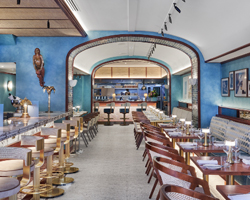 Saltie Girl
Saltie Girl
https://www.saltiegirl.com/location/saltie-girl-london/
Saltie Girl landed in London with a splash, the alter ego of the name (a common monkier for a mermaid) adding a touch of playful personality to a serious side of London. While North Audley Street isn’t shorty of places to help you spend your hard-earned cash, we think this is worth the salary sacrifice. The interiors must have set owner Kathy Sidell back a fair whack, but the investment seems paid off in kind via sheer Instagram appeal. A bar lined with gold, half-moon backed stools, marble tables and intricate mosaic flooring would sing to a place in any generation Z’s heart. Thanks to the smell of warm butter wafting around, it’s hard to avoid ordering the lobster roll that comes generously packed with sweet meat plus a side of salted crisps. Elsewhere there’s a really very good scallop ceviche with just the right amount of citrus and a little crunch from shaved radish, while fat juicy prawns appear headfirst into a swimming pool of rich, spiced tomato cocktail sauce, ready to be rescued.
 Gouqi
Gouqi
https://gouqidev.wpengine.com/
Gouqi is a fine dining Chinese restaurant from seven Michelin-starred chef Tong Chee Hwee, where he brings innovative contemporary Chinese cuisine to St James’s in London. Tong helped to open Hakkasan Hanway Place in 2001, which gained its Michelin star two years later in 2003, before later becoming the executive chef of the entire Hakkasan Group in 2010. Over the years, he’s also led the kitchens at Hakkasan Mayfair, Yauatcha Soho and HKK, before leaving the group in 2019. Gouqi marks the chef’s return to London’s dining scene and is his first solo venture, where he offers a contemporary take on Chinese cooking with a range of la carte, tasting and dim sum menus. The name Gouqi (pronounced like ‘goji’) originated as a play on goji berry, traditionally viewed as a symbol of health and vitality and which informs the ethos of the restaurant. As such, dishes are made using the freshest possible seasonal ingredients and offer a fusion of flavours, techniques and ingredients drawn from across China, as well as parts of Europe. On the a la carte menu, diners are able to tuck into its ‘legendary’ peking duck with Oscietra caviar, as well as other luxurious dishes such as eight treasure crispy chicken with foie gras and a steamed royal dim sum platter. While the eight-course tasting menu combines modern European influences with Chinese flavours to create dishes such as chargrilled silver cod with yellow bean sauce and passion fruit, and black truffle roasted duck with honey-glazed Iberico char siu with salted egg yolk.
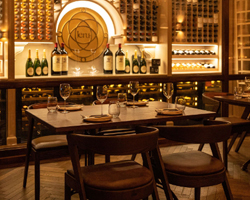 Jeru
Jeru
https://jeru.co.uk/
Middle Eastern restaurant Jeru’s Mayfair post code prepared us mentally for a dining experience reflective of the location: exclusive, expensive and potentially a little stuffy. We scored one out of three for the cost which is eye-watering wherever you look on the menu — nibbles average around £15 and mains start at £32. As for the other two, we were happy to be proven wrong. Diners must enter through the café-cum-bar in order to access the main restaurant, which is rich with the aroma of freshly ground coffee and adds to the immediate feeling of warmth upon entering. The dining area offers a similar sense of conviviality and busyness. An open kitchen runs the length of the room where you can watch the chefs artfully managing multiple steaming pans, including head chef Roy Ner at the fore of it all. It feels fun and welcoming – diners are invited to be part of the action, not hidden from it. A menu of sharing plates continues the theme. We sampled the chef’s selection (£69 a head) which included a moreish wood-fired flatbread lightly speckled with crispy lamb and served with truffle honey for dipping, while wafer-thin, melting slices of basturma (cured beef) were delicate and sliced in front of us at the counter kitchen. Other highlights included hassleback Jerusalem artichokes, crisp on the outside yet velvety within and swimming in a creamy goat’s curd moat. There were more high-performing dishes: halloumi doughnuts with goat’s curd were soft, if a little heavy, while raw kingfish drizzled in a date and lime dressing delivered sweetness and acidity in harmony.
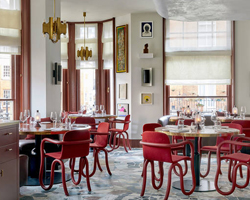 Mount St restaurant
Mount St restaurant
https://mountstrestaurant.com/
Mount St. Restaurant is the jewel in the crown of genius hospitality company Artfarm’s latest project. We say genius, because what they’ve managed to achieve on the first floor of this grandiose building is a thing of beauty. Part of a revamped, five-story property just a few doors down from Scott’s in Mayfair, the modern restaurant is headed up by the highly-talented Jamie Shears who brings an unprecedented level of luminosity to well-known British dishes. It’s a decidedly luxurious dining room, cemented by eye-watering prices and walls flanked by a priceless collection of artworks — Matisse and Warhol are both present. Art and design are central to the restaurant’s concept, although our favourite feature is its beautiful palladiana mosaic floor comprised of a cacophony of marble. It seems a shame to walk all over it. However, the real artistry appears with the food. Sure, these are dishes we’ve had before – Portland crab, meaty croquettes, chocolate mousse — but as our plates arrive, each one more delicious than the last, any previous iterations of their sort we’ve ever eaten seem like mere shadows of the dishes that Shear’s produces.
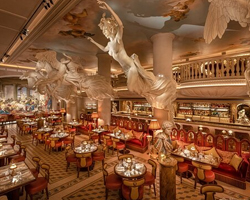 Bacchanalia
Bacchanalia
https://bacchanalia.co.uk/
They say ‘all roads lead to Rome’, and yet cruelly not all culinary journeys are written in the stars to end at Bacchanalia. However, if securing a table here is within your reaches, it is a foodie temple worth worshipping at least once. The venue’s name is inspired by the debaucherous Roman festivals of Baccus, that celebrates the god of wine and pleasure – an insight into the restaurant’s unique concept that combines Roman and Ancient Greek cuisine and culture. Once you’re through the entrance’s red awning, toga-draped hosts will show you to a dining room where gargantuan statues of winged horses and snake-haired goddesses protrude from the ceiling. The devil is in the details, and while the jewel-encrusted bar and themed outfits of the sweet front of house staff certainly got our attention, the small touches are just as mesmerising. Ornate wall lights, velvet room dividers and even the operatic music in the bathroom all makes an impression. This sentiment extends to the cocktails; we chose the Baklava crowned with an edible etching of a Greek god, which mixed butter-washed vodka and sherry with pistachio and honey for a creamy, nutty taste. The food menu is designed for sharing, so we started with creamy burrata split open across sweet, blistered Datterini tomatoes, which balanced freshness and indulgence. Elsewhere, the grilled octopus was the perfect consistency, served with softened Greek ospriada beans. There are plenty of options for mains, but it’s impossible not to be tempted by the section headed ‘Food of the Gods’. These extravagantly large dishes recreate the great feasts from Baccus’ time, and everyone is encouraged to stick a fork in. Here, the whole lobster smothered with paccheri pasta and creamy bisque, sprinkled with fresh shavings of black truffle is the stand-out dish. Finally, for dessert we enjoyed the bonet al cioccolato’s baked chocolate base and how the Amaretto crumble and mandarin segments intervened before it all got too rich.
Hope it helps, please feel free to contact us if you need any further information/recommendations
Будь в курсе!
TELEGRAMПодписывайся на наш Телеграм канал чтобы быть первым в курсе новостей и актульной информации в сфере путешествий.



 Рекомендуем рестораны со всего Мира
Рекомендуем рестораны со всего Мира
